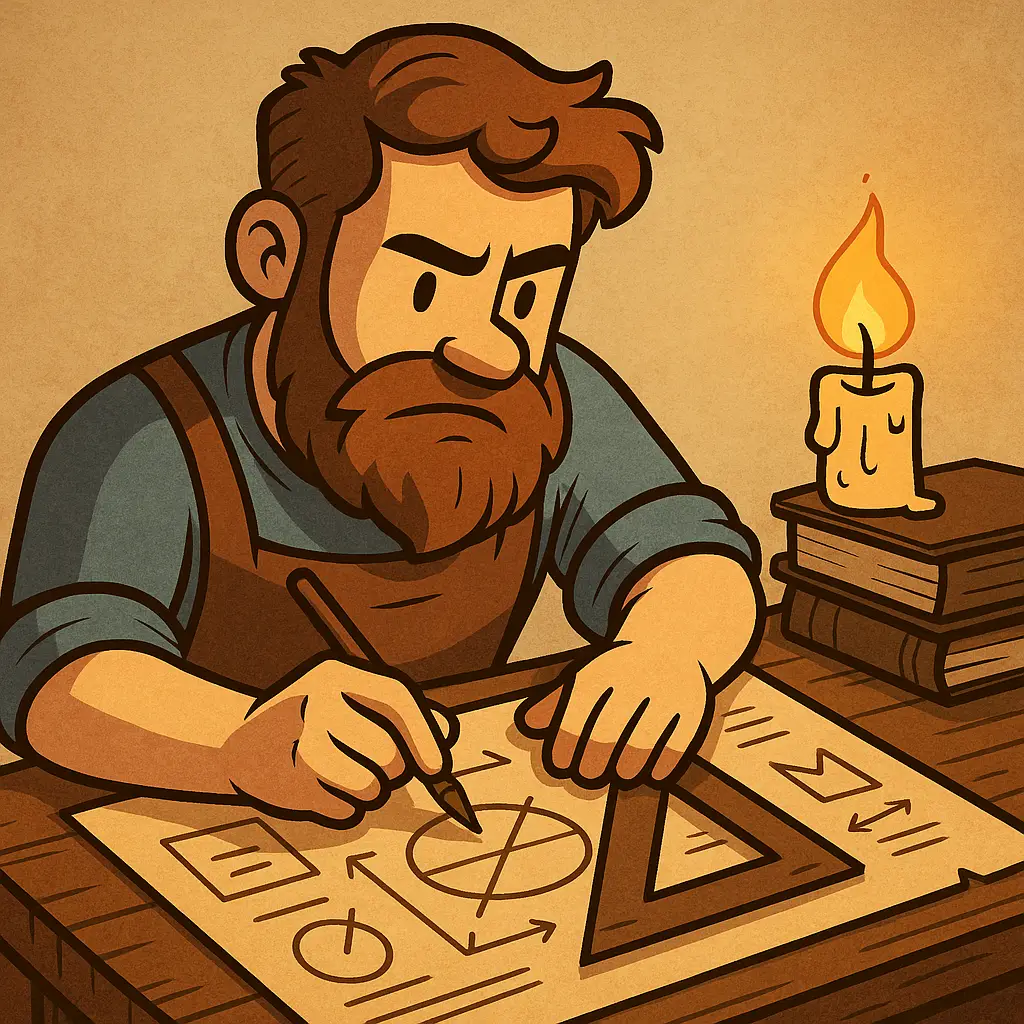Guidelines for introducing custom rules or items without breaking the table
There comes a point in every game master’s life when the rules… just aren’t enough.
Maybe you want to create a new spell that lets your bard charm someone by tap dancing. Maybe your warlock wants a sentient umbrella that shoots fireballs. Or maybe your entire table is bored of existing subclasses and craving something new.
Welcome to the world of homebrew.
It’s exhilarating, creative, and dangerous.
Done well? It’s unforgettable.
Done poorly? It’s campaign-breaking, spotlight-hogging, or worse—it’s boring.
So how do you walk the line between letting your imagination run wild and making sure your game doesn’t fall apart?
Today on RPGInquisitor, we’re diving deep into safe, fun, balanced homebrew design that excites your players without ruining your pacing, spotlight, or sanity.
🧠 First, Understand Why You’re Homebrewing
Before you create a custom class, weapon, or rule variant, ask yourself:
“What is this solving?”
- Is it fixing a mechanical weakness?
- Filling a flavor gap?
- Adding thematic depth?
- Accommodating a unique player concept?
Or are you just adding something because it sounds cool?
Coolness is great, but meaningful design comes from purpose. Know your “why”—it’ll help you shape the “how.”
A new rule should expand choices, not just replace existing ones.
⚔️ Rule #1: Don’t Homebrew Against the Players
Homebrewing isn’t just about giving players new toys. It’s also about setting new expectations. But there’s one golden rule:
Never surprise your players with homebrew designed to punish them.
Examples of what not to do:
- “I didn’t like how easily you beat that encounter, so now all enemies have legendary resistance.”
- “You abused healing potions, so I homebrewed potion sickness into the game… starting now.”
- “I added a stamina system because I think spell slots are too generous.”
Instead, use homebrew to:
- Fix obvious system bugs or dead levels
- Add flavor to underdeveloped features
- Help players engage with narrative and mechanics more meaningfully
You can challenge your players—but don’t target them with homebrew.
⚒ Rule #2: Simpler Is Safer
Most problems in homebrew happen when designs try to do too much at once.
When making a custom:
- Magic item: Focus on 1–2 unique effects, not 5.
- Spell: Use existing spells as a mechanical template.
- Subclass: Borrow core structure from existing options before adding flair.
The more rules you invent from scratch, the harder it is to track, balance, and predict interactions.
Simplicity doesn’t mean boring. It means stable.
Start small. Add complexity later if it earns its keep.
📏 Rule #3: Test with “If This, Then What?”
Let’s say you give your rogue a homebrewed item that lets them turn invisible for 1 round as a bonus action once per short rest.
Sounds fair?
Ask:
- What happens if they use this to sneak into every room?
- Can they stack this with other invisibility effects?
- Is the bonus action cost meaningful in most fights?
- What does this do to enemy threat levels?
Always ask:
- “How can this be abused?”
- “What combos does this enable?”
- “Does this break action economy?”
If you can imagine an unintended exploit, your player will too—even by accident.
Preempt it with clear wording and fair limits.
🎯 Rule #4: Use Familiar Mechanics as Anchors
One of the safest ways to balance homebrew is to ground it in existing mechanics.
Creating a new spell? Start with one in the same level range and modify the effect or flavor.
New subclass? Use a published one as a base, then swap out key features.
New monster? Start with a stat block you trust and reskin it—before you mess with damage dice.
Balance doesn’t mean sameness—but the best homebrew echoes what already works.
This also makes your players more comfortable. They instinctively understand how your new thing fits in.
🧪 Rule #5: Test Before You Commit
Don’t treat homebrew like gospel. Treat it like a patch note.
Let your players know:
“This is in testing. If it feels over- or underpowered, we’ll adjust.”
Then:
- Run controlled one-shots or sidequests
- Use homebrew items on major NPCs to see how they play
- Watch how players use the new thing—not just how they describe it
Be willing to nerf, buff, or revise.
Players will respect your honesty—especially if you include them in the process.
🎭 Rule #6: Design for Drama, Not Just Power
Some of the best homebrew isn’t about stats at all. It’s about roleplay flavor.
Examples:
- A sentient sword that talks only in passive-aggressive poetry
- A magic tattoo that reveals secrets when you lie
- A subclass that trades damage for defense when protecting an ally
Power isn’t always the point.
Sometimes the best homebrew:
- Adds tension
- Creates moral questions
- Pushes characters into tough choices
- Gives spotlight moments to shy players
Don’t underestimate narrative impact as a form of balance.
🧩 Rule #7: Consider the Spotlight Budget
This one’s subtle—but crucial.
Homebrew should not steal the show from other players.
If your custom subclass or item:
- Solves every puzzle
- Bypasses major mechanics
- Makes other PCs feel less relevant
…it’s not just unbalanced mechanically—it’s unbalanced narratively.
Make sure every new rule:
- Has limits
- Encourages team play
- Leaves space for others to shine
A good homebrew feature makes the group better—not just one player.
🔮 Rule #8: Flavor Is Free (But Still Powerful)
You don’t need mechanics to homebrew.
Want a ranger whose animal companion is a pocket-dimension jellyfish? Go for it.
Want a monk who only fights while reciting cooking recipes? Yes, please.
Reskinning and reflavoring existing mechanics lets you customize the story without breaking the math.
Change:
- Spell names
- Class titles
- Weapon descriptions
- Monster behavior
All without ever touching a damage die.
Sometimes the most powerful homebrew is 100% cosmetic—but it sticks in the players’ memory forever.
💡 Rule #9: Write It Like a Rulebook
Clarity prevents conflict.
Whenever you create a new rule, ability, item, or spell—write it down like it’s in the Player’s Handbook.
Include:
- Name
- Activation type (bonus, action, passive)
- Limitations (once per day, recharge, conditional)
- Effects (damage, conditions, area of effect, etc.)
- Fluff or flavor text
Avoid:
- Vague language (“kinda lets you do this…”)
- Over-explaining (“it’s like this spell but if you’re on fire and near a mirror…”)
- Hidden caveats not written in the ability
Treat your homebrew with the same respect you treat published content.
If it’s clear, it’s easier to use, remember, and trust.
📚 Rule #10: Share It and Iterate
You’re not alone.
There are thousands of homebrewers out there with brilliant designs—and thousands of pitfalls you can avoid just by sharing your idea before you unleash it.
Try:
- Posting your homebrew to Reddit, Discord, or a private player group
- Using free feedback forms after playtesting
- Collecting votes on “how strong did this feel?”
Homebrew should be collaborative, not just creative.
And the best homebrew grows over time.
🧠 Bonus Tips for GMs & Players
For GMs:
- Let your players pitch homebrew—but review it before approval.
- If you’re unsure, try limited use items or temporary abilities.
- Use homebrew as rewards for backstory, not just loot.
For Players:
- Don’t treat homebrew as a way to “win” the system.
- Be honest if something feels too strong.
- Use it to roleplay more, not game more.
⚖️ Final Thoughts: Balance Is a Journey
Homebrew isn’t just about making new content.
It’s about asking:
- “What would make this game more exciting?”
- “What if this world worked a little differently?”
- “What if we told our story this way?”
When done thoughtfully, homebrew empowers creativity without wrecking pacing, fairness, or focus.
So go ahead:
- Make the cursed accordion sword.
- Invent the paladin oath of absolute neutrality.
- Let your sorcerer shoot lightning from their kneecaps.
Just make sure it:
- Has a reason
- Has a cost
- Has a place in your story
And above all?
Make it fun—for everyone.

